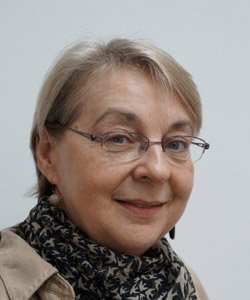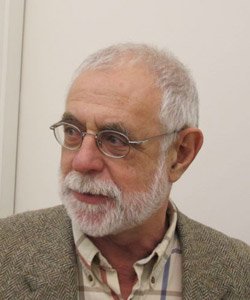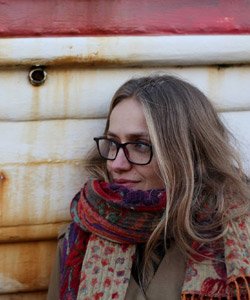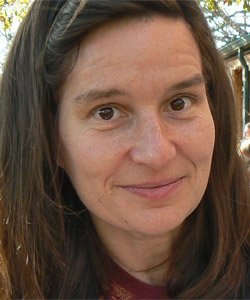26 October 2017 - Session 1
-

Christina Lodder
Exporting a Revolutionary Aesthetic: The Vkhutemas and the Bauhaus
In October 1922, the Erste Russische Kunstausstellung opened in Berlin and presented to the West the first comprehensive view of the extraordinary artistic developments that had been taking place in Russia since the outbreak of the First World War. In 1914, Russian art had been little more than an echo of European developments, but by 1922, German artists were able to see that Russian artists had made considerable strides in articulating new styles and new approaches to art making, some of which were well in advance of their Western colleagues. In fact, from being followers of the European avant-garde, Russian artists had become its leaders. Of course, between the armistice in 1918 and the show in 1922, there had been some information (both visual and verbal) available in the West. Creative figures such as Wassily Kandinsky, Marc Chagall, Ivan Puni, El Lissitzky and others had visited Berlin and presented their work in one-man shows. There had been publications such as Konstantin Umanskii’s book on Russian art and articles in the German press. Nevertheless, these only gave partial views and tantalising glimpses of a wealth of new ideas. They had whetted Western appetites for more. October 1922 saw the first extensive display of Russian innovations - and the impact was considerable.
In this paper, I would like to focus particularly on the influence that innovative approaches to art making and art teaching (as developed in the Moscow Vkhutemas – the Higher State Artistic and Technical Workshops) had on the theory and practice of art teaching at the Bauhaus. The First Russian Art Exhibition included some material about the new approaches to teaching in Russian art schools, including the Vkhutemas, alongside the numerous abstract paintings and constructed sculptures that were on display. The change in Bauhaus production from its earlier Expressionist orientation to its celebration of a more emphatically machine aesthetic from 1923 onwards has been attributed to various factors, including the advent of Wassily Kandinsky and Laszlo Moholy-Nagy as teachers, the presence of Theo van Doesburg in Weimar, and the impact of Russian developments generally. In this paper I would like to explore the idea that the visual material presented at the 1922 exhibition about the way in which art was being made, as well as the way in which such modernist ideas were being taught at the Moscow Vkhutemas were also instrumental in effecting this change in direction. -

Andrei Sarabianov
Die Erste Russische Kuntsaustellung. Refining the Composition of Works.
Die Erste Russische Kunstaustellung – The First Russian Art Exhibition, which opened on October 15, 1922 in the Berlin gallery Van Diemen played an enormous role in the process of acquainting European art experts with the Russian avant-garde. A brief overview of responses to this exhibition, written by Yakov Tugendhold and published in the first issue of Russkoe iskusstvo in 1923, presents important information about this event. From this report, we learn that the press was very surprised that new Russian art demonstrated “such daring and freedom, such desire to reevaluate and recreate all values, which Europe has not seen for decades.” For the first time, the European public saw works by Pavel Filonov, Olga Rozanova, Liubov Popova, and Aleksandr Drevin. For the first time, works by pupils of followers of Kazimir Malevich were shown: Ivan Kliun, Lev Iudin and Anna Kagan. The exhibition also featured early Constructivist models and reliefs by Wladyslaw Strzeminski, Gustav Klutsis, Karl Ioganson, Konstantin Medunetsky, and the Stenberg brothers.
The exhibition displayed nearly 1000 works by approximately 180 artists. The catalogue does not contain many details about the works, making it challenging to determine the exact number of works and their composition, though this situation is remedied somewhat by the high quality of illustrations. Defining the composition of the exhibition is an important research task, and requires the study of collections of the avant-garde in Russia’s regional museums. This presentation will focus on new information about works that were shown at the First Russian Art Exhibition which later could be found in several Russian museums. -

Maria Mileeva
The Reception of Russian Revolutionary Art in Weimar Germany
By reviewing the details of the motives, the preparation and the impact of the "Erste Russische Kunstausstellung" (First Russian Art Exhibition), which took place in Galerie Van Diemen in Berlin (1922), this paper will bring to light new evidence of cross-cultural exchange between Russia and Germany during the 1920s.
Upon seeing the show, Paul Westheim remarked: “The Russian exhibition is not so much a show of art as of art problems.” Further to the three rooms of non-objective art, which have thus far received the greatest amount of scholarly attention, the display showcased more than 700 works by 167 artists. I wish to turn to the great variety of works on display by artists, such as Petr Konchalovsky, Pavel Filonov, Vladimir Kozlinksii, Aleksandr Drevin, and Vladimir Lebedev, amongst others. Seeking to establish the reception of these works by the artistic community in Berlin, I will focus on the impact of the Van Diemen exhibition on such organizations as the Novembergruppe, the Künstlerhilfe of the German Internationale Arbeiter Hilfe (IAH), and the Rote Gruppe. The paper will demonstrate how the first Russian national exhibition in Berlin served as a catalyst for the mobilization of the German highly-politicized leftist artists’ organizations and ensured a greater participation of the Soviet state in cultural affairs abroad.
-

Isabel Wünsche
Revolutionary Alliances: The Russian Avant-garde and the Berlin Art Scene of the 1920s
Following the 1917 October Revolution in Russia and the 1918 November Revolution in Germany, Berlin became home to a large Russian émigré community as well as a lively center of cultural exchange of the artistic avant-gardes. In 1922, the German branch of the international committee of the Workers’ International Relief (an aid organization for those starving in Russia) was responsible for hosting the Erste Russische Kunstausstellung (First Russian Art Exhibition) at the Galerie van Diemen in Berlin. The exhibition had been organized by David Shterenberg on behalf of the People’s Commissariat for Education (Narkompros). Featuring works by Kazimir Malevich, El Lissitzky, Liubov Popova, Aleksandr Rodchenko, Olga Rozanova, and Vladimir Tatlin, the show presented modern and avant-garde art to a German audience for the first time.
Herwarth Walden, owner of the Berlin-based gallery Der Sturm, provided one of the major platforms for the artistic exchange of the avant-garde. From the beginning, he regularly exhibited works by Alexander Archipenko, Marc Chagall, and Wassily Kandinsky. In November 1918, he showed the “Russian Expressionists” Natalia Goncharova and Mikhail Larionov and in January-February 1921 works by Ivan Puni and Ksenia Boguslavskaya. His comprehensive Gesamtschau on the occasion of the ten-year anniversary of the Sturm gallery in August-September 1921 included works by Archipenko, Boguslavskaya, Chagall, Goncharova, Alexei Jawlensky, Kandinsky, Larionov, Puni, and Marianne Werefkin. In 1927 and 1929, he presented marionettes and stage designs by Aleksandra Ekster.
In the 1920s, the presentations of the Novembergruppe (November Group) at the Große Berliner Kunstausstellungen (Great Berlin Art Exhibitions) showcased the international avant-garde. Puni presented his Synthetic Musician in 1922 and Lissitzky his groundbreaking Proun Room in 1923. One of the highlights of the November Group’s presentations at the 1927 Great Berlin Art Exhibition was the personal exhibition of Malevich. In 1926, the Internationale Vereinigung der Expressionisten, Futuristen, Kubisten und Konstruktivisten (International Association of Expressionists, Futurists, Cubists, and Constructivists) presented a spectacular show with works by more than 60 artists of the international avant-garde at the Great Berlin Art Exhibition.
This paper examines Russian-German artistic relations and the participation of Russian avant-garde artists in the activities of the international avant-garde in Berlin in the 1920s. Particular emphasis is given to the networks that evolved around Sturm gallery, the November Group, and the International Association of Expressionists, Futurists, Cubists, and Constructivists, and to the lively interaction among the various art movements (that is, the intensive collaboration of the second generation of Expressionists with the Dadaists and Constructivists) and the productive cooperation between visual artists, designers, architects, and musicians.
